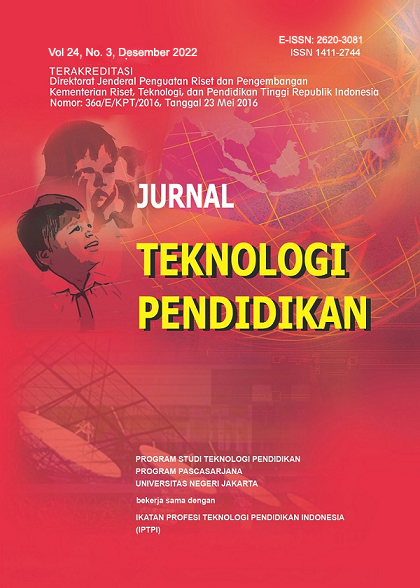Training on the Development of Utilization of Digital Teaching Materials for Teachers to Improve Student Learning Outcomes
DOI:
https://doi.org/10.21009/jtp.v24i3.31799Keywords:
Information Technology, Digital Teaching Materials, Learning Performance, Teacher CompetenceAbstract
In the era of the industrial revolution 4.0, modern technology such as fibre technology and integrated network systems in all aspects of life has made humans very dependent on technology. The purpose of this research is to foster a culture of digital literacy in the school environment, increase teacher knowledge and skills in the field of developing and utilizing digital teaching materials, improve student learning performance and increase teacher knowledge and skills in terms of digital learning models and improve student's learning performance. The method used in this study is the observation method using the pre-experimental design method, one group type pretest-posttest (pretest test-posttest single group). Assistance was provided to 28 junior high school teachers in the South Tangerang area. During the training, participants were given four assignments: Team, Sway, Learning Design and Learning Videos. The study results show that as many as 71% of teachers have mastered the Teams and Sway applications from Microsoft, 60% can make lesson plans, and 53% can make learning videos. The pretest and post-test results showed that the average result was 36.6%, then after participating in the training, the average result was 44.4%. The results of the study show that training in the development and use of digital teaching materials has an effect on the skills and abilities of teachers, which is beneficial for improving student learning performance.
References
Armstrong, P. (2015). partnerships and collaboration for school improvement : a review of the evidence October 2015. Research Report, October, 1–47. https://www.gov.uk/government/publications/school-improvement-effective-school-partnerships
Azzahra, N. F., & Felippa, A. (2021). Promoting Digital Literacy Skill for Students through Improved School Curriculum. Policy Brief, May, 1–14. http://hdl.handle.net/10419/249444www.econstor.eu
Büyükbaykal, C. I. (2015). Communication Technologies and Education in the Information Age. Procedia - Social and Behavioral Sciences, 174, 636–640. https://doi.org/10.1016/j.sbspro.2015.01.594
Coman, C., Țîru, L. G., Meseșan-Schmitz, L., Stanciu, C., & Bularca, M. C. (2020). Online teaching and learning in higher education during the coronavirus pandemic: Students’ perspective. Sustainability (Switzerland), 12(24), 1–22. https://doi.org/10.3390/su122410367
Dhawan, S. (2020). Online Learning: A Panacea in the Time of COVID-19 Crisis. Journal of Educational Technology Systems, 49(1), 5–22. https://doi.org/10.1177/0047239520934018
HENRY PRAHERDHIONO. (2017). https://teknologipendidikan.org/teknologi-pada-media-pembelajaran-2/. August 19.
Mpungose, C. B. (2020). Emergent transition from face-to-face to online learning in a South African University in the context of the Coronavirus pandemic. Humanities and Social Sciences Communications, 7(1), 1–9. https://doi.org/10.1057/s41599-020-00603-x
Munir. (2009). Pembelajaran Jarak Jauh berbasis Teknologi Informasi dan Komunikasi (TIK) [Distance Learning based on Information and Communication Technology (ICT)].
RonnyScherera JoTondeurb Fazilat Siddiqc EvrimBarand. (2018). he importance of attitudes toward technology for pre-service teachers’ technological, pedagogical, and content knowledge: Comparing structural equation modeling approaches. Computers in Human Behavior, 80, 67–80.
Rukminingsih, Adnan, G., & Latief, M. A. (2020). Metode Penelitian Pendidikan. Penelitian Kuantitatif, Penelitian Kualitatif, Penelitian Tindakan Kelas. In Journal of Chemical Information and Modeling (Vol. 53, Issue 9).
Selatan, P. T. (2019). Pemkab Tangerang Selatan. https://e-sakip.tangerangselatankota.go.id/assets/file/renstra/46-RENSTRA-2019.
Smaragdina, A. A., Nidhom, A. M., Soraya, D. U., & Fauzi, R. (2020). Pelatihan Pemanfaatan dan Pengembangan Bahan Ajar Digital Berbasis Multimedia Interaktif untuk Menghadapi Era Revolusi Industri 4.0. Jurnal KARINOV, 3(1), 53. https://doi.org/10.17977/um045v3i1p53-57
Sugiyono. (2016). Metode Penelitian Kuantitatif, Kualitatif dan R&D. Bandung: PT Alfabet.
Sumintono, B., Hidayat, R., Patras, Y. E., Sriyanto, J., & Izzati, U. A. (2019). Leading and Managing Schools in Indonesia: Historical, Political and Socio-cultural Forces. Perspectiveson School Leadership in Asia Pacific Contexts, 31–45.
Sungkono. (2009). Pengembangan Dan Pemanfaatan Bahan Ajar Modul Dalam Proses Pembelajaran. Majalah Ilmiah Pembelajaran, 5–1.
Suparwito, H., Polina, A. M., & Budiraharjo, M. (2021). Student Perceptions Analysis of Online Learning: A Machine Learning Approach. Indonesian Journal of Information Systems, 4(1), 64–75. https://doi.org/10.24002/ijis.v4i1.4594
Sutarto, S., Sari, D. P., & Fathurrochman, I. (2020). Teacher strategies in online learning to increase students’ interest in learning during COVID-19 pandemic. Jurnal Konseling Dan Pendidikan, 8(3), 129. https://doi.org/10.29210/147800
Taufik, A., Saidi, S., & Apendi, T. (2019). Analysis the Hidden Advantages of Written Pretests for Student Intelligence. International Journal for Educational and Vocational Studies, 1(7), 713–718. https://doi.org/10.29103/ijevs.v1i7.1677
Williamson, B. (2017). Williamson Big Data Education Chapter1 2017. September 2017.
Downloads
Published
How to Cite
Issue
Section
License
Jurnal Teknologi Pendidikan is an Open Access Journal. The authors who publish the manuscript in Jurnal Teknologi Pendidikan agree to the following terms.
Attribution-ShareAlike 4.0 International (CC BY-SA 4.0)
-
Attribution — You must give appropriate credit, provide a link to the license, and indicate if changes were made. You may do so in any reasonable manner, but not in any way that suggests the licensor endorses you or your use.
-
ShareAlike — If you remix, transform, or build upon the material, you must distribute your contributions under the same license as the original.
- No additional restrictions — You may not apply legal terms or technological measures that legally restrict others from doing anything the license permits.
Notices:
- You do not have to comply with the license for elements of the material in the public domain or where your use is permitted by an applicable exception or limitation.
- No warranties are given. The license may not give you all of the permissions necessary for your intended use. For example, other rights such as publicity, privacy, or moral rights may limit how you use the material.








